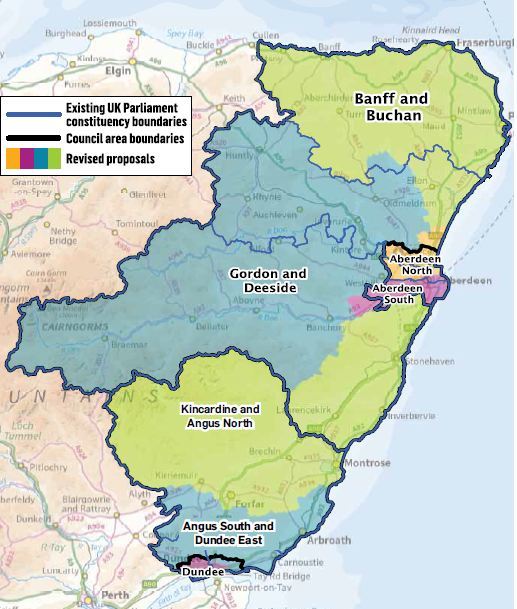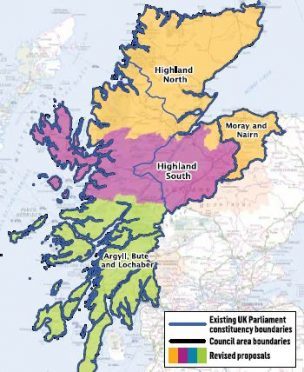Shock proposals could lead to Inverness being dropped from the title of the city’s Westminster constituency for the first time in a century.
Under revised plans for a controversial boundary shake-up, a new “Highland South” seat would be created in place of the existing “Inverness, Nairn, Badenoch and Strathspey”.
It would end 100 years of tradition, with Inverness having been included in various constituency names since 1918.
The change would also leave the Highland capital as the only Scottish city not to feature in the title of a seat in the Commons.
City MP Drew Hendry branded the idea “baffling” last night, as the Boundary Commission for Scotland unveiled its latest plans to cut the number of constituencies from 59 to 53.
And the Ross, Skye and Lochaber constituency, held by SNP Westminster leader Ian Blackford, would effectively be dismantled under the proposals, with the number of Highland seats being cut from four to three.
Mr Blackford branded the move a “democratic outrage” last night, but predicted the changes would not go ahead.
Last year, the commission revealed it wanted to break up Britain’s largest constituency – Ross, Skye and Lochaber – with most of Wester Ross joining the existing Caithness, Sutherland and Easter Ross to form a new “Highland North” seat, which would become the biggest, geographically.
Meanwhile, much of Lochaber would join with the existing Argyll and Bute constituency, and Skye and Lochalsh would be combined with the Inverness seat.
The latter was initially to be named “Inverness and Skye”, but is now to become “Highland South”.
Nairn was due to be removed from the Inverness constituency to recreate a “Moray and Nairn” seat, which existed from 1918 to 1983, and would have the most voters in Scotland, at 78,477.
The new proposed boundaries make few changes to those announced for the Highlands last year, except the controversial new name for the Inverness and Skye seat, and the inclusion of Mallaig in that constituency.
Last night, Mr Hendry said: “Proposals that reduce representation in the Highlands through the creation of these enormous constituencies shows just how out of touch Westminster is with our region.
“Even the proposed names ‘Highland South and North’ give people no clue over where boundaries start and finish, and highlight the lack of appreciation of the history and status of our region.
“I find it particularly baffling they have decided to remove the name of our only Highland city from the constituency name – for the first time in over 100 years.
“It just goes to show how little thought they have given to our feedback to their consultation and their complete lack of knowledge that Inverness is one of Europe’s fastest growing cities.”
Asked about dropping Inverness from the seat name, Boundary Commission member Professor Ailsa Henderson said yesterday: “we tried to simplify things”.
She added that the body could not take account of the geographical size of seats when setting boundaries, but Mr Blackford responded it was a “piece of nonsense” 40% of Scotland’s landmass would be contained in three constituencies.
The high-profile politician, who would face battling one of his SNP colleagues in the three neighbouring constituencies for selection if the changes went ahead, added: “I think going from four Highland constituencies to three is an absolute democratic outrage.”
However, Mr Blackford added: “I don’t expect this to go ahead because I don’t think there’s a parliamentary majority.”

Banchory will remain in the same Westminster constituency as other Deeside communities if a controversial boundary shake-up goes ahead.
The town was earmarked to be included in a new Kincardine and Angus East seat last year, sparking concern and hundreds of consultation responses.
But revised proposals published today by the Boundary Commission for Scotland show Banchory being moved into a newly created Gordon and Deeside seat, in recognition of its links and shared geography.
The move has had a knock-on impact on proposals for other north-east seats, however.
A new Kincardine and Angus North seat is suggested, featuring more Angus communities, including Brechin, while Aberdeen South would extend west to include Drumoak, Aberdeen North would extend north to Balmedie, Belhelvie and Potterton, and Banff and Buchan would extend south to Newburgh.
Gordon MP Colin Clark said: “Banchory is a good Conservative area – I’ll be delighted if it’s in there.”
However, the Conservative added: “Whether or not the constituencies will change looks unlikely. There was enthusiasm for boundary change a number of years ago but I’m not sure there is enthusiasm for it now.”
Consultation begins
An eight-week consultation begins today on the revised House of Commons boundary proposals – but there are calls to scrap the process.
The Conservatives have long campaigned for constituency sizes to be “equalised”, with studies previously showing the party could gain up to 20 seats as a result.
The 2010 coalition government agreement pledged the “creation of fewer and more equal-sized constituencies”, and subsequent legislation made provision to reduce the size of the Commons from 650 to 600 seats.
Scotland’s 59 constituencies were to be reduced to 53, with the existing boundaries of the Western Isles and Orkney and Shetland protected by law.
However a boundary review was hit by delays and now there are doubts that the Conservatives could command enough support in Westminster to push through controversial seat changes, particularly with the DUP unlikely to back Theresa May’s government.
Last night, northern isles Liberal Democrat MP Alistair Carmichael branded it a “dead-duck boundary review”.
He said: “The DUP will not wear this review. Nor will many Tory backbenchers. The government should stop wasting public funds and bow to the inevitable.”
Chris Skidmore, UK Government minister for the constitution, said: “These revised proposals from the independent and impartial Boundary Commission will now be subject to further consultation and careful consideration.
“A Boundary Review is needed to ensure fair and equal representation for the voting public across the United Kingdom by the next general election.
“Without any boundary reforms, constituencies would be based on data that is over 20 years’ old. This would disregard significant changes in demographics, house building and migration.”
The consultation will run until December 11.
